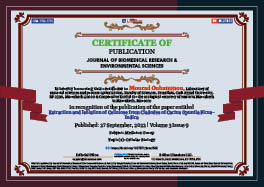Mourad Ouhammou*, Abderrahim Jaouad, Mohamed Bouchdoug and Mostafa Mahrouz
Volume3-Issue9
Dates: Received: 2022-09-21 | Accepted: 2022-09-26 | Published: 2022-09-27
Pages: 1108-1111
Abstract
Cellulose is the most abundant material in the earth, it is considered a renewable polymer of the cell walls of wood and plant cells, their interest and their use in different field is the purpose of extracting it namely: cellulose native (cotton), the transformation of cellulose into sheets (paper and filter paper), cupric cellulose, zinc cellulose (industrial applications), the functionalization of cellulosic materials in the field of printed electronics, textile, treatment, medicine, and agribusiness.
The objective of this study, is the extraction of cellulose at several stages and recovery of a waste based on old cactus rackets, type Opuntia ficus -indica smooth. The cellulose extracted showed good isolation, dispersion and purification of nanofibrils by the removal of oils, mucilage, pectins, hemicellulose and coloring substances. The substitution of ethanol by acetone in the extraction protocol used [1], gave suspensions of purified cell walls is well individualized, on the other hand the cellulose extracted from the beet pulp, chuck pulp prickly pear fruit peel requires a mechanical homogenizer.
FullText HTML
FullText PDF
DOI: 10.37871/jbres1562
Certificate of Publication

Copyright
© 2022 Ouhammou M, et al. Distributed under Creative Commons CC-BY 4.0
How to cite this article
Ouhammou M, Jaouad A, Bouchdoug M, Mahrouz M. Extraction and Isolation of Cellulose from Cladodes of Cactus Opuntia Ficus-Indica. J Biomed Res Environ Sci. 2022 Sep 27; 3(9): 1108-1111. doi: 10.37871/jbres1562, Article ID: JBRES1562, Available at: https://www.jelsciences.com/articles/jbres1562.pdf
Subject area(s)
References
- Youssef Habibi. Contribution à l’Etude Morphologique, Ultra Structurale et Chimique de la Figue de Barbarie, les Polysaccharides Pariétaux : Caractérisation et Modification Chimique. 2004.
- Mathieu Mazza. Modification chimique de la cellulose en milieu liqu ide ionique et CO2 supercritique. 2009.
- Service communication délégation Alpes du CNRS : "La cellulose : matériau de demain", Pascale Natalini.
- KhennaouI Badis. Etude, synthèse et obtention de matériaux Composites à partir de Cellulose de Polyacrylamide et de Polystyrène. 2009.
- E Chanliaud. Extraction, caractérisation et propriétés fonctionnelles des hétéroxylanes de son de maïs", Thèse de doctorat n° 1995EIAA0043, ENSIA, Université Paris XI, Université Paris VII, pp129, 1995.
- Isogai A. Wood and cellulosic chemistry, 2nd Ed, revised and expanded, Ed. DNS Hon N Shiraishi, chap 14, Chemical modification of cellulose, pp599-625, 2000.
- Nakagaito AN, Yano H. Novel high-strength biocomposites based on microfibrillated cellulose having nano-order-unit web-like network structure. Applied Physics. 2003;80:155-159.
- Aidoud A. Les parcours à alfa des hautes plaines algériennes. Variation inter-annualle et productivitè. 4eme CITP, Mentpellier (France). 1991;198-199.
- Rachid Bouhdadi. Cellulose acylation by 3-pyridinoyl chloride hydrochloride: Application to lead Pb2+ adsorption. Comptes Rendus Chimie. 2011;14:539-547.
- Olivier PRAS. Utilisation de cellulose pour l’élaboration de matériaux photoluminescents ou conducteurs. 2011.
- KeKe Zhang. Improve the flame retardancy of cellulose fibers by grafting zinc ion, Carbohydrate Polymers. 2016;136:121–127.
- Bouddah Poaty. Modification of cellulose nanocrystals as reinforcement derivatives for wood coatings, Progress in Organic Coatings. 2014;77:813–820.
- Hongling Wang, Xianghui Qi, Chanson Gao, Yifeng Zhang, Yingfeng Un. Biochemical characterization of an engineered bifunctional xylanase/feruloyl esterase and its synergistic effects with cellulase on lignocellulose hydrolysis. Bioresource Technology. 2022;355. doi: doi.org/10.1016/j.biortech.2022.127244.